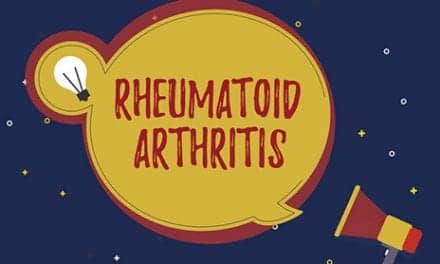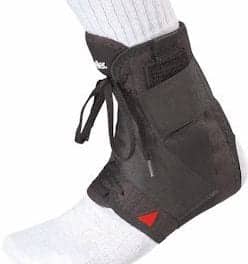
Uzo Igwegbe, PT, MPT, fitting a stroke survivor with the thigh component of the Bioness L300 Go, targeted at stimulating the L hamstrings to minimize L knee hyperextension in stance during ambulation.
By Uzo Igwegbe, PT, MPT
Foot drop, a gait abnormality, is an insufficient ability to dorsiflex or clear the foot/feet during the swing phase of gait, causing an increased risk for stumbling, falls, or injury. In a normal gait cycle, initial foot contact occurs with the heel; however, an individual with foot drop may drag the foot and/or make initial contact with the forefoot or foot flat. To compensate they may excessively flex the hip and knee, or circumduct the affected limb, or increase time spent in swing phase of the affected extremity.
The cause of drop foot is due to damage to the common fibular (peroneal) nerve (inclusive of the sciatic nerve), weakness or paralysis of the tibialis anterior, extensor halluces longus and extensor digitorum longus. Foot drop is associated with cerebrovascular accident/stroke, brain injury, multiple sclerosis, cerebral palsy, spinal cord injury, spinal stenosis, disc herniation, poliomyelitis, diabetes mellitus, Charcot-Marie-Foot Disease, muscular dystrophy, Amyotrophic Lateral Sclerosis, or direct injury to the peroneal nerve.
Ankle foot orthotics (AFOs) and Functional Electric Stimulation (FES) technologies are used in the management and treatment of drop foot in physical therapy. These two approaches strive to facilitate a natural gait with increased speed, improved balance, confidence, safety, and independence with ambulation and functional mobility.
[sidebar float=”right” width=”250″]Product Resources
The following companies provide products to treat ankle injuries, foot drop and other aspects of stroke and neurological rehabilitation:
Active Ankle
www.activeankle.com
Allard USA Inc
www.allardusa.com
APDM
www.apdm.com
GAITRite/CIR Systems Inc
www.gaitrite.com
Gorbel Medical/SafeGait
www.safegait.com
Mobility Research
www.litegait.com
Motorika Medical Ltd
www.motorika.com
Ottobock
www.ottobockus.com
ProtoKinetics
www.protokinetics.com
Saebo Inc
www.saebo.com
Solo-Step
www.solostep.com
Tekscan
www.tekscan.com
Vista Medical
www.boditrak.com
Woodway USA
www.woodway.com[/sidebar]
Orthotic Management
Ankle foot orthotics, the most common approach used, support neutral foot position to facilitate clearance during swing and provide ankle stability during loading response.1 AFOs are either off the shelf (for short-term use) or custom made from a cast (for complex cases or long-term use). These L-shaped braces are worn in footwear and, in most cases, a larger shoe size of one half to a full shoe size may be required due to the bulk of the orthosis. To obtain an AFO, a correct foot drop diagnosis by the therapist/physician and a physician’s AFO prescription is needed to proceed with a comprehensive assessment, with recommendations of treatment options from a licensed orthotist. A cast impression of the foot and leg is done for custom AFO. Follow-up appointments are done after reception of the AFO for re-evaluation of fit and function. The AFOs prescribed for drop foot include:
1) Posterior Leaf Spring AFO: This prefabricated, semi-rigid, polypropylene AFO supports individuals with mild foot drop and knee instability. It provides dorsiflexion during swing and controls plantarflexion at heel strike. Resistance to plantarflexion can be controlled by modifying the ankle and footplate trim lines. This AFO is the initial “go-to” brace for physical therapists because they are readily available, lightweight, inexpensive, and can provide initial ankle stability early in rehabilitation; however, there are newer, lighter, more comfortable, user-friendly and functional models available. Sources for these types of AFOs include Orthotic & Prosthetic Lab Inc, Webster Groves, Mo, which makes the Dynamic ROM AFO, and Orange County, Calif-headquartered, Össur Americas, which offers a prefabricated, polypropylene AFO Leaf Spring.
2) Solid AFO: This custom-fabricated plastic AFO prevents plantarflexion and prevents/limits dorsiflexion. It supports the ankle-foot complex in the coronal and sagittal planes in individuals with complete or nearly complete loss of dorsiflexion and mild to moderate knee hyperextension. Although bulky, it provides significant ankle support. It is contraindicated in individuals with fluctuating edema due to its rigid structure. Its bulk, difficulty obtaining properly fitted footwear, and general discomfort due to heat generated from continuous use can be barriers to utilization. One source for these devices is Kiser’s Orthotic and Prosthetic Services Inc, Keene, NH, which manufactures its solid ankle AFO to help combat spasticity, help the toe to clear, and prevent the Achilles tendon from tightening.
3) Free Motion Articulating AFO: The ankle joint here is activated, so the individual must have active ankle motion. It is commonly prescribed for individuals with some dorsiflexion, but who still need frontal plane stability. It is not recommended for patients with significant quadriceps weakness. Among the products available in this category is the Exos Free Motion Ankle from DJO Global Inc, Vista, Calif; a prefabricated AFO made to be moldable, adjustable, and can be custom fit. Becker Orthopedic, Troy, Mich, also offers a plastic AFO with articulating ankle, which can be used with a variety of the company’s thermoplastic ankle joints and posterior stops.
4) Short Leg AFO with Fixed Hinge: A good option for people who have flatfoot and drop foot, this AFO holds the foot at 90 degrees to the lower leg and controls unwanted inward rotation of the foot, which is common in stroke and Charcot-Marie Tooth patients. It is relatively light and easily fits footwear. A disadvantage of this brace, and the solid AFO, is its failure to provide a natural gait. Among the sources that offer this type of orthoses is New Linox, Ill-headquartered Rinella Orthotics & Prosthetics Inc.
5) Dorsiflexion Assist AFO: This has a spring-like hinge which assists the ankle with dorsiflexion as the foot comes off the ground for those with mild to moderate drop foot, and a flat or unstable foot as it offers a more natural gait pattern. The short lower leg length of this brace and the Short Leg AFO fails to provide adequate support in people over 6 feet or 225 pounds.
6) Plantarflexion Stop AFO: This brace prevents plantarflexion and has a hinge that facilitates normal dorsiflexion. Due to its cumbersome size, it is not utilized often but can be effective in people with more severe or spastic drop foot. Orthotic & Prosthetic Lab Inc provides plantarflexion stop AFOs that are designed to prevent unwanted plantarflexion while permitting free dorsiflexion. These AFOs are also available from Yakima, Wash-headquartered Yakima Orthotics & Prosthetics, and are designed to provide medial/lateral stability and plantarflexion/dorsiflexion control.
7) Energy Return AFO: This prefabricated, lightweight AFO is made of carbon graphite material. It provides assistance in dorsiflexion and energy return at push-off to propel the individual forward with plantarflexors. It provides stability only in the sagittal plane; however, a foot orthotic can be placed on the flat foot for frontal plane stability. In stroke and spina bifida patients, carbon-fiber AFOs increased walking speed and decreased energy cost when compared to unbraced walking.2 Research suggests that Energy Return AFOs facilitate plantar flexor muscle regeneration and prevents atrophy.3,4
Therapists have a number of choices in this category, including the ToeOff carbon composite dynamic response floor reaction AFO from Allard USA Inc, Rockaway, NJ; designed to keep the foot up during swing phase as well as provide soft heel strike and stability in stance. In addition to providing good toe-off to the wearer, the company recommends this AFO for foot drop in combination with no spasticity to moderate spasticity. The Ypsilon, also from Allard, is made to provide toe-off assistance to stable ankles while also allowing natural ankle movement, while the company’s BlueROCKER provides more rigid orthopedic control and was developed for bilateral foot drop. It can be used for foot drop in combination with no spasticity to severe spasticity, as well as partial foot amputations, impaired balance, and weakness or impairment in multiple leg muscle groups. The Peromax carbon fiber AFO and Trulife Matrix Max carbon fiber AFO are two other options available to the PT market in this category.
Users with big toe plantar ulcerations who are unable to cope with the plastic AFO due to skin breakdown from continuous pushing off the foot plate can have the addition of a custom foot orthotic, which can help offload those areas. Items like a heel lift can be placed under the foot plate to control for knee hyperextension. Despite their advantages, this AFO is not ideal for individuals with large calves or very tall individuals, as their long stride repeatedly overextend and weaken the AFO, or individuals with spastic drop foot or tight Achilles tendon, as the overactivity of the muscle pushes down on the foot plate, excessively hyperextending the knee.

Therapist is shown fitting a stroke survivor with the lower leg cuff of the Bioness L300 Go to stimulate the tibialis anterior muscle to improve L foot clearance during ambulation.

Performing the initial stimulation testing to determine whether the desired muscle activation is elicited prior to ambulation.
Functional Electrical Stimulation Management
The L300 Foot Drop System and WalkAide are approved medical devices for foot drop by the US Food and Drug Administration and are used in rehabilitation hospitals. The Bioness Legacy L300, L300 Go, and WalkAide consist of a lower leg cuff which holds electrode(s), providing low-level electrical stimulation to an intact peroneal nerve. The L300 Go and WalkAide use advance tilt sensor technology to monitor movement in all three kinematic planes, providing stimulation to lift the foot at the appropriate time. This makes foot clearance at various cadence and terrains feasible. They do not require a foot sensor like the Legacy L300, decreasing setup time and allowing users to ambulate with or without footwear. They can be used if knee instability and foot drop are present, promoting clinical application as majority of individuals present with both. Patients work alongside a clinician to obtain training for home use or utilize these technologies in the clinical setting.
Conclusion
The options available in the treatment and management of foot drop are numerous. The path to obtaining the right product involves a joint partnership between the patient, physical therapist, physician, and orthotist. The clinician must draw from the patient’s needs, abilities, facets of gait needing improvement, and special conditions specific to the patient to recommend the optimal product. In the choice between an AFO and FES device, the ultimate goal is to provide a product that will yield compliance, a normalized gait, and contribute to independent function. PTP
Uzo Igwegbe, PT, MPT, is outpatient physical therapist, senior, at HealthSouth Rehabilitation Hospital of Cypress, located in Houston, Texas. She earned her master’s degree in physical therapy at The Robert Gordon University in Aberdeen, Scotland, in February 2010. She joined HealthSouth Rehabilitation Hospital in January 2012, starting at the City View location in Fort Worth, Texas, working in both inpatient and outpatient settings, developing treatment plans for pulmonary, brain injury and orthopedics patients. Igwegbe joined the HealthSouth Cypress team in September 2013, where she primarily worked with outpatients with a wide range of neuromuscular and musculoskeletal conditions, as well as post-orthopedic surgery patients. For more information, contact [email protected].
References
1. Farley J. Controlling drop foot: Beyond standard AFOs. Lower Extremity Review. 2009.
2. Danielsson A, Sunnerhagen K. Energy expenditure in stroke subjects looking with a carbon composite ankle foot orthosis. J Rehabil Med. 2004;36(4):165-168.
3. Wolf SI, Alimusaj M, Rettig O, Doderlein L. Dynamic assist by carbon fiber spring AFOs for patients with myelomeningocele. Gait Posture. 2008;28(1):175-177.
4. Meier RH, Ruthsatz DC, Cipriani D. Impact of AFO (ankle foot orthosis) design on calf circumference. Lower Extremity Review. 2014;6(10):29-35.







